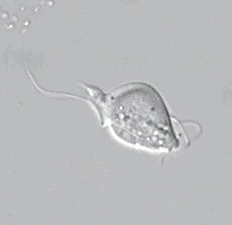Tritrichomonas foetus is an emerging parasite of felines. With this article we have attempted to answer the most common questions regarding the clinical presentation and the diagnosis of this infection.

Figure 1. Tritrichomonas foetus trophozoite seen on a saline wet mount of a faecal specimen. It has a characteristic oval shape with anteriorly directed flagella and a single, posteriorly directed flagellum (from https://blogs.cornell.edu)
Aetiology. Tritrichomonas foetus is a protozoal parasite determined to be a causative agent of chronic diarrhoea in the cat.
Transmission. Feline trichomonosis is a disease with a faecal-oral route of spread. T. foetus is incapable of prolonged survival outside the host (<1h), but can survive for several days in moist stools. Therefore, transmission from cat to cat via shared litter boxes is relatively frequent.
Clinical signs vary from subclinical to intractable large bowel diarrhoea. T. foetus-associated diarrhoea waxes and wanes, is semi formed to a soft, unformed consistency rather than liquid, and is not associated with signs of systemic illness. Clinical signs are reported to persist for several months from the time of diagnosis. More than half of the cats that go into clinical remission will have PCR evidence of infection (asymptomatic carrier), and many of these cats will relapse for a short duration, often with worse diarrhoea. Mortality is extremely rare and only reported in kittens.
Co-infections. A detail analysis of enteropathogen co-infection in UK cats with diarrhoea showed infection with T. foetus in cats can be associated with infection by Giardia duodenalis and Cryptosporidium spp.
Risk factors. T. foetus infection should be considered as a possible differential diagnosis in a cat with recent clinical signs of chronic large bowel diarrhoea. The prevalence of infection has been reported to be higher in younger and purebred cats.
Diagnosis. Diagnosis of infection is made by either examination of the direct faecal smear or culture (both with low sensitivity), or preferably by the use of PCR faecal samples. Testing for this parasite is still not routine at most veterinary clinics. T. foetus looks similar to Giardia when viewed under a microscope, and as a result misdiagnosis as Giardia is common. Therefore, T. foetus-specific tests must be performed to diagnose it.
PCR testing has excellent sensitivity, but false negative results may occur. Possible reasons for failure to detect infection include:
- Intermittent shedding of the parasite
- Use of old, dried out, non-diarrheic, refrigerated or litter-contaminated faeces
- Cat is currently or has recently received antibiotics (<7d)
- Insufficient quantity of sample submitted (submit at least 1g of faeces)
- Numbers of foetus are below the detection limit of the test
Sample requirements. 3 days pooled diarrheic faeces and possibly free from litter, as formed stool rarely tests positive even if a subclinical shedder. Faecal samples should be kept unrefrigerated before testing as the organism does not survive refrigeration.
PCR testing for T. foetus is available at Battlab on 3 day pooled unrefrigerated faecal samples, with the turnaround time of 1-2 working days only. BattLab also offers a complete service of gastroenterology testing, including PCR for enteropathogenic E. Coli and customised E. Coli vaccines.



